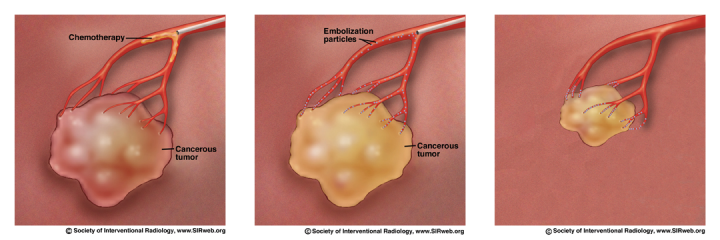Chemoembolisation of Tumours
What is Chemoembolisation?
Chemoembolisation is a minimally invasive treatment performed by interventional radiologists to treat cancers (tumours) that have spread to the liver.
The main objective of the treatment is to deprive the tumour of the nourishment brought by the blood supply, by embolising its arteries (embolisation) and administering citostatics (anti-cancer drug) directly into the tumour.
Why is Chemoembolisation performed?
In this way, the damage to healthy tissues is avoided and the tumour is starved by cut off the blood supply, which causes its shrinkage. Chemoembolisation is used for large tumours, particularly hepatocellular carcinoma (liver cancer), in cases when the tumour can not be treated by radiofrequency ablation (RFA), or as a combination with other cancer treatments (radiation therapy, RFA).
How is Chemoembolisation performed?
Using imaging for precise guidance, interventional radiologist threads the tiny catheter through the femoral artery (which is located in the groin) up to the artery that supplies liver tumour with the blood. When the desired location is reached the embolic agent and citostatic are injected through the catheter.

Will I need to stay in hospital after having this procedure?
This procedure requires in hospital stay for a couple of days varying on the overall status of every individual patient.
Which cancers is it most effective for?
Chemoembolisation is a palliative treatment and is effective for primary liver cancers particularly when combined with other treatments.
Further research
There are some promising results for treatment of metastatic tumours, but there is still more research to be conducted.
Useful Links
Author: Dr John Vrazas MB,BS FRANZCR
